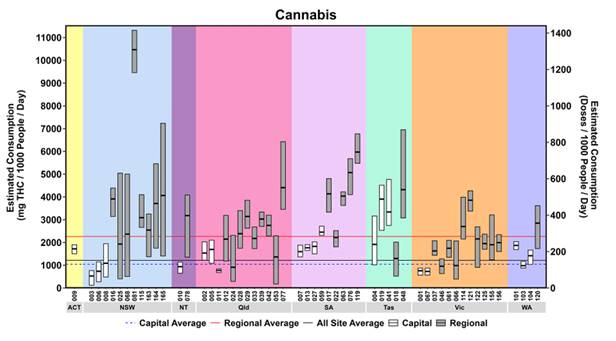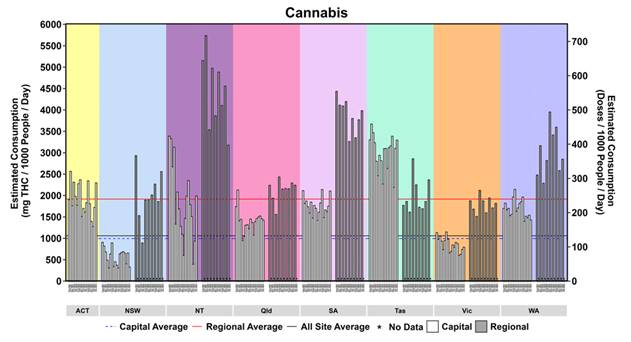Use
This section provides information about the ways in which Australians use cannabis. It addresses how much and how often Australians use cannabis, the most common types used, and methods and locations of use.
The primary source of data used in this section is the 2022-23 National Drug Strategy Household Survey (NDSHS) (Australian Institute of Health and Welfare, 2024). The NDSHS is a triennial general population survey of Australians' awareness, attitudes, and behaviours relating to alcohol and other drug use. It is the best data source available to provide a national population demographic profile of Australians’ cannabis use behaviours.
What proportion of Australians have used cannabis?
Approximately two-fifths (41%) of Australians have used cannabis in their lifetime, 12% have used cannabis in the past 12 months, 7% have used in the past month, and 5% have used in the past week.
Source: Australian Institute of Health and Welfare (AIHW). 2022-23 National Drug Strategy Household Survey.
Are men or women in Australia more likely to have used cannabis?
Australian men are more likely than women to have used cannabis in their lifetime, the past 12 months, the past month and the past week.
Source: Australian Institute of Health and Welfare (AIHW). 2022-23 National Drug Strategy Household Survey.
Please note: Significance is established as p<0.05. Australians who identify as non-binary or a different gender identity were not able to be included in the current analyses due to small numbers.
Are younger or older Australians more likely to have used cannabis?
Cannabis use varies according to age. In general, young adults (particularly those aged 18-29 years) are more likely to have used cannabis recently.
Source: Australian Institute of Health and Welfare (AIHW). 2022-23 National Drug Strategy Household Survey (NCETA secondary analysis, 2024).
Significance is established as p<0.05.
Has cannabis use in Australia changed over time?
Lifetime cannabis use has increased over time, from 33% in 2001 to 41% in 2022-23, seeing a significant increase from 37% in 2019.The proportion of recent (past 12 month) cannabis users decreased from 2001 (13%) to 2007 (9%), then increased, reaching 12% in 2022-23.
Source: Australian Institute of Health and Welfare (AIHW). 2022-23 National Drug Strategy Household Survey.
Is the employment status of Australians related to cannabis use in the past 12 months?
Australians who are employed and unemployed are similarly likely to have used cannabis in the past 12 months. Those not in the labour force are the least likely to have used cannabis in the past 12 months.
Source: Australian Institute of Health and Welfare (AIHW). 2022-23 National Drug Strategy Household Survey (NCETA secondary analysis, 2024).
Significance is established as p<0.05.
Employed: Self-employed or working for salary or wages.
Employment Status: Whether an individual is currently: a) employed; b) unemployed; or c) not in the labour force.
Not in the Labour Force: Engaged in home duties, volunteer/charity work, student, retiree/pensioner, other.
Unemployed: Not currently working and actively seeking employment.
In which industries are Australian employees more likely to have used cannabis in the past 12 months?
The proportion of employed Australians who used cannabis in the past 12 months varies according to industry of employment. Cannabis use is highest in the hospitality (22%), administrative and support services (20%) and construction (19%) industries.
Source: Australian Institute of Health and Welfare (AIHW). 2022-23 National Drug Strategy Household Survey (NCETA secondary analysis, 2024).
Significance is established as p<0.05.
Employed: Self-employed or working for salary or wages.
What is the average age at which Australians start to use cannabis?
Among Australians aged 14 years and older who have ever used cannabis, the average age at which they first tried it was 19 years.
Source: Australian Institute of Health and Welfare (AIHW). 2022-23 National Drug Strategy Household Survey.
Has the average age at which Australians start to use cannabis changed over time?
Among Australians aged 14 years or older who have ever used cannabis, the average age at which they first tried it has remained stable at 19 years between 2001 and 2022-23.
Among Australians aged 14-29 years who have ever used cannabis, the average age at which they first tried it has increased significantly over time: between 2001 and 2010 the average age of initiation was 16 years; however, it increased to 18 years in 2019 and has remained at 18 years in 2022-23.
Source: Australian Institute of Health and Welfare (AIHW). 2022-23 National Drug Strategy Household Survey.
What forms of cannabis do Australians use?
Among Australians who used cannabis in the past 12 months, the majority (86%) used herbal forms of cannabis (bud, head, leaf), followed by edibles (e.g. brownies) (9%).
Source: Australian Institute of Health and Welfare (AIHW). 2022-23 National Drug Strategy Household Survey.
Do men and women in Australia use different forms of cannabis?
Among Australians who used cannabis in the past 12 months, both men (89%) and women (80%) predominantly used herbal forms of cannabis (bud, head, leaf), followed by edibles (e.g brownies). Men were more likely than women to use herbal forms of cannabis, while women were more likely than men to use edibles or medicinal cannabis products.
Source: Australian Institute of Health and Welfare (AIHW). 2022-23 National Drug Strategy Household Survey.
Please note: Significance is established as p<0.05. Australians who identify as non-binary or a different gender identity were not able to be included in the current analyses due to small numbers.
* Estimate has a relative standard error of 25% to 50% and should be used with caution.
Do younger and older Australians use different forms of cannabis?
Among Australians who had used cannabis in the past 12 months, herbal forms were the most commonly used by all age groups. Younger Australians were more likely to use herbal forms of cannabis, while older Australians were more likely to use medicinal forms of cannabis.
Source: Australian Institute of Health and Welfare (AIHW). 2022-23 National Drug Strategy Household Survey (NCETA secondary analysis, 2024).
Significance is established as p<0.05.
* Estimate has a relative standard error of 25% to 50% and should be used with caution.
** Estimate has a relative standard error greater than 50% and is considered too unreliable for general use.
How do Australians use cannabis?
Most Australians who used cannabis in the past 12 months mainly smoked it as a joint (50%) or in a bong or pipe (35%).
Source: Australian Institute of Health and Welfare (AIHW). 2022-23 National Drug Strategy Household Survey.
Do men and women in Australia use cannabis differently?
Australian men and women who used cannabis in the past 12 months were both most likely to smoke it as a joint. Men were relatively more likely than women to smoke it from a bong or pipe or inhale it through a vape, while women were relatively more likely than men to eat it.
Source: Australian Institute of Health and Welfare (AIHW). 2022-23 National Drug Strategy Household Survey (NCETA secondary analysis, 2024).
Please note: Significance is established as p<0.05. Australians who identify as non-binary or a different gender identity were not able to be included in the current analyses due to small numbers.
Do younger and older Australians use cannabis differently?
Among Australians who used cannabis in the past 12 months, the most common main method of use in all age groups was smoking it as a joint, followed by using a bong or pipe. The exception to this was 14-17 year olds, where a higher proportion smoked cannabis from a bong or pipe than as a joint.
Source: Australian Institute of Health and Welfare (AIHW). 2022-23 National Drug Strategy Household Survey (NCETA secondary analysis, 2024).
Please note: Percentages do not tally to 100% as respondents could select more than one response. Significance is established as p<0.05.
* Estimate has a relative standard error of 25% to 50% and should be used with caution.
** Estimate has a relative standard error greater than 50% and is considered too unreliable for general use.
Where do Australians obtain cannabis?
The majority (61%) of Australians who used cannabis in the past 12 months usually obtained it from a friend.
Source: Australian Institute of Health and Welfare (AIHW) 2022-23 National Drug Strategy Household Survey.
Where do Australians usually use cannabis?
Among Australians who used cannabis in the past 12 months, the majority (90%) typically used it in a private home.
Source: Australian Institute of Health and Welfare (AIHW). 2022-23 National Drug Strategy Household Survey.
Please note: Percentages do not total to 100% as respondents could select more than one location.
How often do Australians use cannabis?
Among Australians who used cannabis in the past 12 months, the largest proportion (32%) used once or twice a year. In 2022-23, approximately one in six (18%) used every day, which has significantly increased from 14% in 2019.
Source: Australian Institute of Health and Welfare (AIHW). 2022-23 National Drug Strategy Household Survey.
Do men or women in Australia use cannabis more often?
Among Australians who used cannabis in the past 12 months, men were more likely than women to use frequently (every day or once a week). Women were more likely than men to use every few months, or once or twice per year.
Source: Australian Institute of Health and Welfare (AIHW). 2022-23 National Drug Strategy Household Survey.
Please note: Significance is established as p<0.05. Australians who identify as non-binary or a different gender identity were not able to be included in the current analyses due to small numbers. Percentages may not tally to 100% due to rounding.
Do younger or older Australians use cannabis more often?
Among Australians who used cannabis in the past 12 months, frequency of use varied by age, with those aged 50 years or older more likely to use more frequently (weekly or daily).
Source: Australian Institute of Health and Welfare (AIHW). 2022-23 National Drug Strategy Household Survey (NCETA secondary analysis, 2024).
Significance is established as p<0.05.
* Estimate has a relative standard error of 25% to 50% and should be used with caution.
What proportion of Australians who use cannabis use other drugs concurrently?
The majority of Australians who used cannabis in the past 12 months used at least one other drug at the same time. Alcohol (74%) was the drug most often used with cannabis, followed by tobacco (41%).
Source: Australian Institute of Health and Welfare (AIHW). 2022-23 National Drug Strategy Household Survey.
Please note: Percentages do not tally to 100% as survey respondents could select more than one drug type.
Do levels of cannabis in wastewater in Australia vary by geographic location?
The amount of cannabis found in Australian wastewater varies substantially between Australian jurisdictions†.
The Australian Criminal Intelligence Commission reported that cannabis consumption in regional South Australia and the Northern Territory is consistently among the highest in the country, while Hobart has the highest consumption level of capital cities. In general cannabis use was higher in regional areas than in capital cities.
Estimated cannabis consumption for April 2024 in mass consumed per day (left axis)^

Estimated average cannabis consumption per jurisdiction, August 2023 to June 2024 in mg consumed per day per thousand people^

^ The number of collection days varied from 5-7 days
Source: Australian Criminal Intelligence Commission (2024). National Wastewater Drug Monitoring Program: Report 23. Canberra: ACIC.
Source: Australian Criminal Intelligence Commission (2024). National Wastewater Drug Monitoring Program: Report 23. Canberra: ACIC.
† This FAQ uses data from the National Wastewater Drug Monitoring Program. Tetrahydrocannabinol (THC) is the main psychoactive compound in cannabis. Cannabis consumption was measured by its urinary metabolite, 11-nor-9-carboxy-∆9-tetrahydrocannabinol (THC-COOH).
